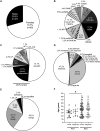Overlapping Presentations and Diverse Genetic Defects Characterize Neuroendocrine Neoplasms in a Mexican Cohort
- PMID: 39908201
- PMCID: PMC12448596
- DOI: 10.1210/clinem/dgaf075
Overlapping Presentations and Diverse Genetic Defects Characterize Neuroendocrine Neoplasms in a Mexican Cohort
Abstract
Context: Genetic tests are part of the routine clinical approach to syndromic and nonsyndromic phenotypes of neuroendocrine neoplasms (NENs). Current data on phenotype-genotype associations in NENs, however, do not accurately represent all populations.
Objective: To describe the frequency, inventory, and clinical associations of germline defects associated with multiple types of NENs in a Mexican cohort.
Methods: Blood DNA from Mexican adults with NENs was analyzed with a 53-gene next-generation sequencing panel developed ad hoc (n = 90) or Sanger sequencing (n = 2). Single nucleotide variants, indels, and structural variants were identified, classified, and subjected to orthogonal confirmation. When possible, tumor samples and blood DNA from additional family members were tested using Sanger sequencing.
Results: Ninety-two probands (70.7% women, 51.5% sporadic) were included; 16 carried pathogenic or likely pathogenic (P/LP) variants and were significantly younger at disease onset than the rest (29.6 ± 10.7 vs 40 [21.5-51.5] years, P = .0384). Likely driving variants were identified in three-quarters of Von Hippel Lindau syndrome cases, one-third of multiple endocrine neoplasia (MEN) type 1, one-quarter of early-onset acromegaly/gigantism, and individual cases of Cushing's disease, MEN2A, and medullary thyroid carcinoma. One patient with clinical MEN1 associated with an SDHA variant and 1 with a pituitary tumor and neurofibromatosis type 1 were also identified. Probands with familial disease were more likely to carry P/LP variants than sporadic cases (26.7 vs 8.5%, P = .0282).
Conclusion: P/LP variants were identified in 17.4% of individuals with NENs. Our research provides a view of the landscape of NEN drivers in a population not previously characterized.
Keywords: familial isolated pituitary adenoma; multiple endocrine neoplasia; neuroendocrine neoplasm; next-generation sequencing; paraganglioma/pheochromocytoma; pituitary neuroendocrine tumor.
© The Author(s) 2025. Published by Oxford University Press on behalf of the Endocrine Society.
Figures

References
MeSH terms
LinkOut - more resources
Full Text Sources
Research Materials
Miscellaneous

